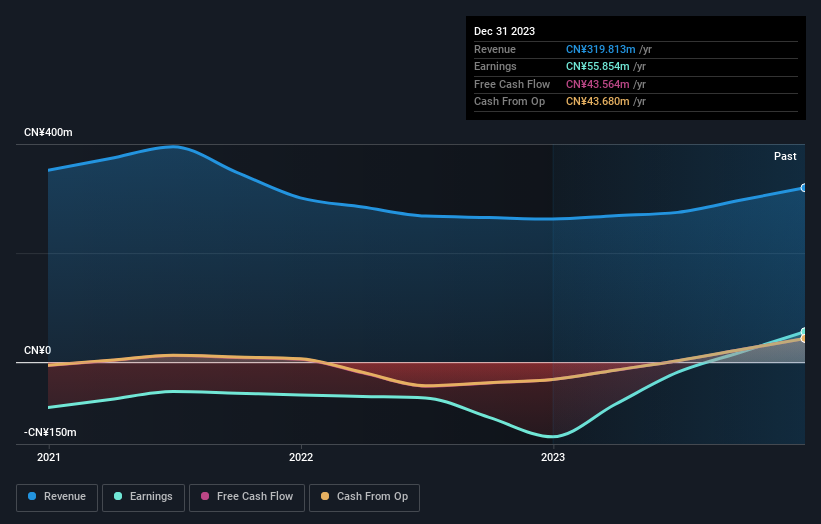- Hong Kong
- /
- Specialty Stores
- /
- SEHK:1280
Private companies in China Qidian Guofeng Holdings Limited (HKG:1280) are its biggest bettors, and their bets paid off as stock gained 27% last week

Key Insights
- Significant control over China Qidian Guofeng Holdings by private companies implies that the general public has more power to influence management and governance-related decisions
- The top 4 shareholders own 50% of the company
- Insiders have bought recently
To get a sense of who is truly in control of China Qidian Guofeng Holdings Limited (HKG:1280), it is important to understand the ownership structure of the business. With 43% stake, private companies possess the maximum shares in the company. Put another way, the group faces the maximum upside potential (or downside risk).
As a result, private companies collectively scored the highest last week as the company hit HK$1.1b market cap following a 27% gain in the stock.
Let's delve deeper into each type of owner of China Qidian Guofeng Holdings, beginning with the chart below.
See our latest analysis for China Qidian Guofeng Holdings

What Does The Lack Of Institutional Ownership Tell Us About China Qidian Guofeng Holdings?
Institutional investors often avoid companies that are too small, too illiquid or too risky for their tastes. But it's unusual to see larger companies without any institutional investors.
There could be various reasons why no institutions own shares in a company. Typically, small, newly listed companies don't attract much attention from fund managers, because it would not be possible for large fund managers to build a meaningful position in the company. It is also possible that fund managers don't own the stock because they aren't convinced it will perform well. Institutional investors may not find the historic growth of the business impressive, or there might be other factors at play. You can see the past revenue performance of China Qidian Guofeng Holdings, for yourself, below.

Hedge funds don't have many shares in China Qidian Guofeng Holdings. Chongqing Saint Information Technology Co., Ltd. is currently the company's largest shareholder with 31% of shares outstanding. For context, the second largest shareholder holds about 8.9% of the shares outstanding, followed by an ownership of 5.5% by the third-largest shareholder. Li Yuan, who is the second-largest shareholder, also happens to hold the title of Top Key Executive.
Our research also brought to light the fact that roughly 50% of the company is controlled by the top 4 shareholders suggesting that these owners wield significant influence on the business.
While it makes sense to study institutional ownership data for a company, it also makes sense to study analyst sentiments to know which way the wind is blowing. We're not picking up on any analyst coverage of the stock at the moment, so the company is unlikely to be widely held.
Insider Ownership Of China Qidian Guofeng Holdings
The definition of an insider can differ slightly between different countries, but members of the board of directors always count. Management ultimately answers to the board. However, it is not uncommon for managers to be executive board members, especially if they are a founder or the CEO.
Insider ownership is positive when it signals leadership are thinking like the true owners of the company. However, high insider ownership can also give immense power to a small group within the company. This can be negative in some circumstances.
It seems insiders own a significant proportion of China Qidian Guofeng Holdings Limited. Insiders have a HK$275m stake in this HK$1.1b business. This may suggest that the founders still own a lot of shares. You can click here to see if they have been buying or selling.
General Public Ownership
The general public-- including retail investors -- own 31% stake in the company, and hence can't easily be ignored. While this group can't necessarily call the shots, it can certainly have a real influence on how the company is run.
Private Company Ownership
We can see that Private Companies own 43%, of the shares on issue. Private companies may be related parties. Sometimes insiders have an interest in a public company through a holding in a private company, rather than in their own capacity as an individual. While it's hard to draw any broad stroke conclusions, it is worth noting as an area for further research.
Next Steps:
While it is well worth considering the different groups that own a company, there are other factors that are even more important. Be aware that China Qidian Guofeng Holdings is showing 5 warning signs in our investment analysis , and 4 of those are significant...
Of course this may not be the best stock to buy. Therefore, you may wish to see our free collection of interesting prospects boasting favorable financials.
NB: Figures in this article are calculated using data from the last twelve months, which refer to the 12-month period ending on the last date of the month the financial statement is dated. This may not be consistent with full year annual report figures.
New: AI Stock Screener & Alerts
Our new AI Stock Screener scans the market every day to uncover opportunities.
• Dividend Powerhouses (3%+ Yield)
• Undervalued Small Caps with Insider Buying
• High growth Tech and AI Companies
Or build your own from over 50 metrics.
Have feedback on this article? Concerned about the content? Get in touch with us directly. Alternatively, email editorial-team (at) simplywallst.com.
This article by Simply Wall St is general in nature. We provide commentary based on historical data and analyst forecasts only using an unbiased methodology and our articles are not intended to be financial advice. It does not constitute a recommendation to buy or sell any stock, and does not take account of your objectives, or your financial situation. We aim to bring you long-term focused analysis driven by fundamental data. Note that our analysis may not factor in the latest price-sensitive company announcements or qualitative material. Simply Wall St has no position in any stocks mentioned.
About SEHK:1280
China Qidian Guofeng Holdings
An investment holding company, engages in the retail of household appliances, mobile phones, computers, and imported and general merchandise in the People’s Republic of China.
Moderate and fair value.

